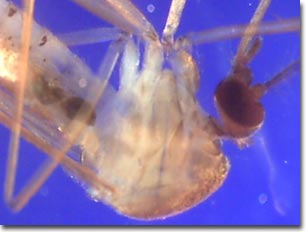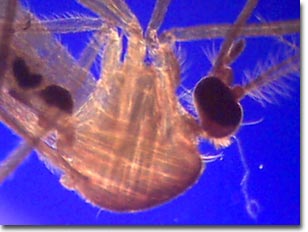Advanced Condenser Systems: Abbe Condensers
Culex (Mosquito)
The digital images presented below were recorded with a QX3 microscope body and an Abbe substage condenser equipped for transmitted Rheinberg illumination. These photomicrographs are unretouched and were captured with the QX3 interactive software.
Culex (Mosquito)

(Blue Central and Red/Yellow Annular Gels)

with Abbe Condenser
(Blue Central and Red/Yellow Annular Gels)
The Culex genus of mosquitoes has a worldwide distribution and is found on every continent except Antarctica. Fourteen species occur throughout the United States and Canada. Many species of Culex are known as the "house mosquito" because these insects commonly develop in small containers around houses. The main host for Culex is wild birds, but it also feeds on a wide variety of warm-blooded vertebrates, including humans.
Culex is a carrier of viral encephalitis and, in tropical and subtropical climates, of filariasis. In the United States, they are disease vectors for western equine and Saint Louis encephalitis. They are also vectors for the West Nile virus that suddenly appeared in the Queens borough of New York City in the summer of 1999, killing six people. The virus, established in Africa and Europe, was most likely introduced into the United States by accident. When exactly this happened is subject to debate. The virus may have been in the states for years, but until people started dying from it, one knew about it. Given that Culex and birds are found everywhere there are people in North America, this disease is probably here to stay.
Semi-transparent specimens are difficult to image using unaided brightfield optical microscopy. The images above were recorded using the Intel Play QX3 microscope in transmitted brightfield mode with the assistance of Rheinberg illumination. Dyed acetate gel filters were strategically placed below the aperture diaphragm of an aftermarket Abbe-style condenser to generate the Rheinberg effect. A 15-millimeter central filter was surrounded by a larger annular filter to combine the effects of oblique specimen illumination by light filtered through the annular filter superimposed over a background of light filtered through the central filter.
BACK TO INTEL QX3 ADVANCED RHEINBERG GALLERY
